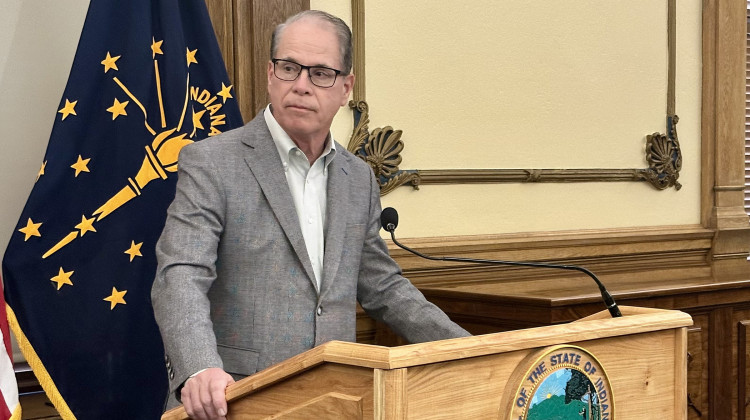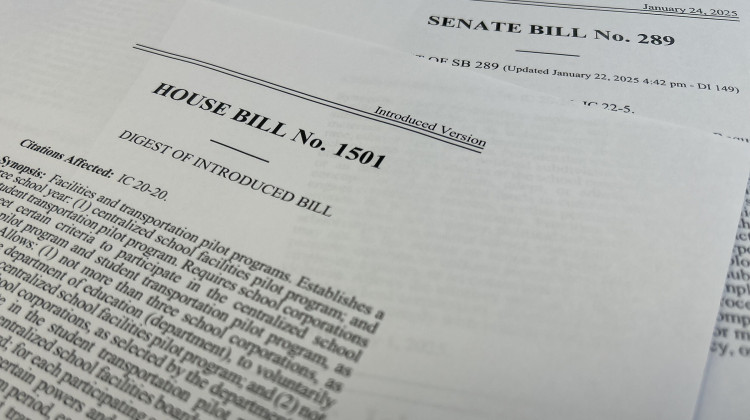
A "graphic recording" of the Graduation Pathways Committee's discussion on Sept. 26, 2017, as illustrated by Mike Fleisch. Photo: Eric Weddle/WFYI
Starting next year, students will have a new way to qualify for high school graduation.
What it will be, or how many options they can choose from, is still unknown.
A committee of lawmakers, education leaders, lobbyists and others are trying to hash out new, so-called “pathways” for students to earn a diploma.
The goal is to boost vocational and academic skills in the face of the state’s skills gap in workers, and students still struggling in basic college classes.
Earlier this year the General Assembly charged the State Board of Education with creating new graduation requirements to do just that. The legislation is open-ended, giving authority to the board to make possibly substantive changes that could impact every student in the state.
That’s making schools leaders anxious about what the proposal could be. After five meetings of the Graduation Pathways Committee, few concrete ideas have appeared to gain traction.
School leaders have made a repeated request: offer one type of diploma for students, instead of the current four.
“It is very important for schools to provide students with multiple pathways to get to that one diploma,” says Jack Russell, president of Center Grove School Board. “This allows schools to better serve all students…not just those who will pursue a traditional college degree.”
Jeff Butts, Wayne Township superintendent and president of the Indiana Association of Public School Superintendents, asked the committee last week to put ideas on paper.
“A version of the draft that can be discussed,” he said. “And certainly to give enough time for reflection before the end of this panel’s work.”
State board member Byron Ernest, who is leading the committee, says drafting will begin at the Oct. 10 meeting. The full plan is to be submitted to the board in December.
“The goal is to really close that gap between where they are at the point of coming out of school, and getting them either employable, college ready and that piece of it, or military,” Ernest says.
Now, students take an end of course exam in math and English to earn a Core 40 diploma. Students who don’t pass the exams can earn a General Diploma but under a new federal education law it would no longer count for a school’s graduation rate.
The committee is weighing additional ways students can qualify, including passage of the military entrance exam, the SAT, ATC, or earning an industry certificate.
The legislation also allows the state board to pick another option.
What lawmakers hope this leads to is students taking more rigorous academic courses and other students would intern with local businesses or other vocational preparation to pass the graduation requirement test associated with their pathway.
Twenty percent of students who graduate with a Core 40 diploma require remediation and 50 percent of students with a general diploma need remediation in college.
Around 47 percent of Indiana’s workers have the training to fill so-called “middle-skill” jobs positions that don’t require a four-year degree, according to a recent report from the National Skills Coalition. More than half of Indiana’s labor market accounts for those type of job, the organization says.
Bruce Watson, director of facilities at Fort Wayne Metals testified to the committee, says more of the “middle-skill” workers are needed to help Indiana’s industry. His company makes wires for medical devices and is growing from nine percent to 20 percent a year.
“I have 14 facilities now and I can’t keep up,” Watson says. “I can’t hire people to maintain our growth. And part of the problem we see is the alternative skills are not being offered in the primary schools.”
But Principal David Maugel from Nappanee testified that one-size-fits-all proposals — from requiring internships to focusing on regional job needs — make school leaders nervous.
“Flexibility must exist in options for students based on the school’s ability to provide facilities programs within their school and their local community,” he says. “Recognition of the regional needs should be a part of graduation pathways but not limited to the original regional needs.”
The Graduation Pathway Panel meets Oct. 3, 10, 17 and Nov. 7 at 9 a.m. at the Indiana State Library, History Reference Room 211.
 DONATE
DONATE




 View More Articles
View More Articles



 Support WFYI. We can't do it without you.
Support WFYI. We can't do it without you.